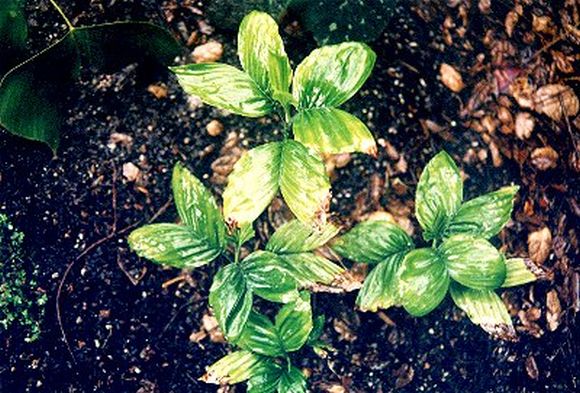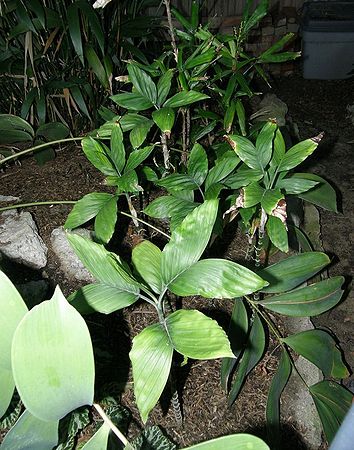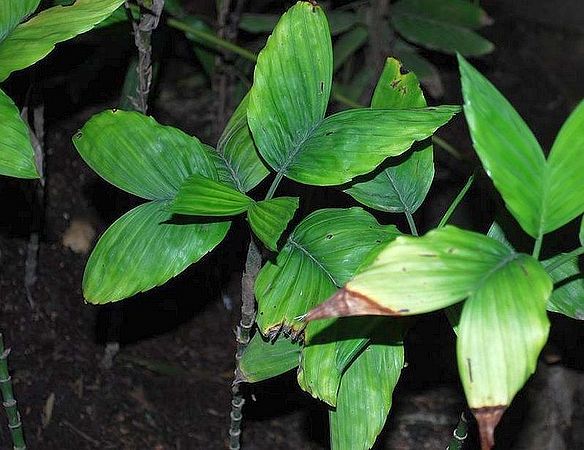Difference between revisions of "Chamaedorea correae"
| (8 intermediate revisions by 2 users not shown) | |||
| Line 1: | Line 1: | ||
__noeditsection__ | __noeditsection__ | ||
{{Palmbox | {{Palmbox | ||
| − | |image=15114_180z.jpg | + | |image=15114_180z.jpg|Loran Whitelock garden, Los Angeles, California; photo by Geoff Stein |
|image_caption= | |image_caption= | ||
|genus=Chamaedorea <br>(kahm-eh-doh-REH-ah) | |genus=Chamaedorea <br>(kahm-eh-doh-REH-ah) | ||
| Line 20: | Line 20: | ||
}} | }} | ||
==Habitat and Distribution== | ==Habitat and Distribution== | ||
| − | ''Chamaedorea correae'' is found in | + | ''Chamaedorea correae'' is found in Panama's higher wet elfin forest mainly on the [[Image:Chamcor0002z.jpg|thumb|left|400px|Whitelock garden, Los Angeles, California; photo by Geoff Stein]]Atlantic slope at 800-l,000 m elevation. |
| − | [[Image:Chamcor0002z.jpg|thumb|left| | + | |
==Description== | ==Description== | ||
| − | + | With its solitary decumbent stem this dainty palm creeps along the moss littered floor of the wind-sweep elfin cloud forest, rooting at the nodes. It is often times supported in part among the shrubs and other plants in the area. The prominently ringed stems may be briefly erect to 1 meter and with a diameter of 5-1- mm. with the prostrate portion often times longer than the erect portion. | |
| − | + | With its growth habit and thicker gray-green leaves, it is one of the more easily identified in the genus. Editing by edric. | |
| − | + | ||
| − | + | ||
| − | With | + | |
| − | + | ||
==Culture== | ==Culture== | ||
Requires consistently moist soil; do not let dry out between waterings, suitable for growing in containers. | Requires consistently moist soil; do not let dry out between waterings, suitable for growing in containers. | ||
| + | <center> | ||
| + | [[{{PFC}}http://www.palmpedia.net/palmsforcal/index.php5/Chamaedorea_correae]] | ||
| + | </center> | ||
==Comments and Curiosities== | ==Comments and Curiosities== | ||
| − | Chamaedorea | + | It is rare in cultivation having been only recently introduced into a few collections in the Hawaii, California, Florida, and Australia. |
| + | |||
| + | Chamaedorea is a [[dioecious]] genus- meaning male and female flowers occur on separate plants. The Greek is translated to mean “gift on the ground” - possibly referring to the small stature and pleasant surprise of finding such a gem at your feet. | ||
| − | + | The epithet honors Mireya Correa, botanist and professor at the University of Panama. | |
<br style="clear:both;"/> | <br style="clear:both;"/> | ||
| Line 42: | Line 42: | ||
image:15114_180z.jpg | image:15114_180z.jpg | ||
image:Chamaedorea_correaez.jpg | image:Chamaedorea_correaez.jpg | ||
| − | image:Chamcor0001.jpg|photo by Geoff Stein | + | image:Chamcor0001.jpg|Whitelock garden, Los Angeles; photo by Geoff Stein |
| − | image:Chamcor0002z.jpg|photo by Geoff Stein | + | image:Chamcor0002z.jpg|Whitelock garden, Los Angeles; photo by Geoff Stein |
| − | image:Chamaedorea corrae Whtlck.jpg|California; photo by Geoff Stein | + | image:Chamaedorea corrae Whtlck.jpg|Whitelock garden, Los Angeles, California; photo by Geoff Stein |
image: | image: | ||
image: | image: | ||
Latest revision as of 09:38, 10 January 2016
| Chamaedorea (kahm-eh-doh-REH-ah) correae ((KOHR-reh) | |||||||
|---|---|---|---|---|---|---|---|
 | |||||||
| Scientific Classification | |||||||
| |||||||
| Synonyms | |||||||
|
| |||||||
| Native Continent | |||||||
|
| |||||||
| Morphology | |||||||
| |||||||
| Culture | |||||||
|
| |||||||
| Survivability index | |||||||
|
| |||||||
| Common names | |||||||
|
| |||||||
Contents
Habitat and Distribution
Chamaedorea correae is found in Panama's higher wet elfin forest mainly on the Atlantic slope at 800-l,000 m elevation.Description
With its solitary decumbent stem this dainty palm creeps along the moss littered floor of the wind-sweep elfin cloud forest, rooting at the nodes. It is often times supported in part among the shrubs and other plants in the area. The prominently ringed stems may be briefly erect to 1 meter and with a diameter of 5-1- mm. with the prostrate portion often times longer than the erect portion. With its growth habit and thicker gray-green leaves, it is one of the more easily identified in the genus. Editing by edric.
Culture
Requires consistently moist soil; do not let dry out between waterings, suitable for growing in containers.
Comments and Curiosities
It is rare in cultivation having been only recently introduced into a few collections in the Hawaii, California, Florida, and Australia.
Chamaedorea is a dioecious genus- meaning male and female flowers occur on separate plants. The Greek is translated to mean “gift on the ground” - possibly referring to the small stature and pleasant surprise of finding such a gem at your feet.
The epithet honors Mireya Correa, botanist and professor at the University of Panama.
- IMAGE GALLERY
External Links
References
Phonetic spelling of Latin names by edric.
Special thanks to Geoff Stein, (Palmbob) for his hundreds of photos.
Special thanks to Palmweb.org, Dr. John Dransfield, Dr. Bill Baker & team, for their volumes of information and photos.
Glossary of Palm Terms; Based on the glossary in Dransfield, J., N.W. Uhl, C.B. Asmussen-Lange, W.J. Baker, M.M. Harley & C.E. Lewis. 2008. Genera Palmarum - Evolution and Classification of the Palms. Royal Botanic Gardens, Kew. All images copyright of the artists and photographers (see images for credits).
Hodel, D.R.1992. Chamaedorea Palms, The Species and Their Cultivation.The International Palm Society.
Many Special Thanks to Ed Vaile for his long hours of tireless editing and numerous contributions.








